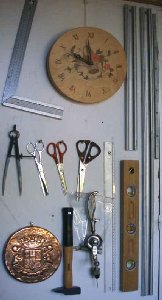
TOOLS OF THE INLAYER 
Hereafter are indexed the tools or products the most used in marquetry, whatever the technique used.
DRAWING AND DUPLICATION



 To reproduce the drawings on their
exact scale, the use of the photocopy is the most current means, or
the pulling of plans for the largest plans.
To reproduce the drawings on their
exact scale, the use of the photocopy is the most current means, or
the pulling of plans for the largest plans. To carry out its
drawing, it is sometimes very practical to use tools known as of CAD: Drawing
Computer-assisted.
To carry out its
drawing, it is sometimes very practical to use tools known as of CAD: Drawing
Computer-assisted.
Tools of vectorial the drawing type
have the advantage of being able to modify a drawing easily, to reduce it or
increase it, to use a starting image to carry it out, to print it using fine
features (1/10 E of mm).
If one carries out modifications of scale,
for another use of the same drawing, one always obtains with the impression of
the identical features. That is very practical for marquetry, in order to obtain
a better precision.
These vectorial tools offer the possibility of
coloriser the drawings to obtain an outline before the work of wood. They
also make it possible to draw by superposable copies, so that it is
easyto add a plan and to adjust it with its own way.
Moreover,
certain tools make it possible to voluntarily modify the drawing, for
example to obtain deformations, to make dissolves of several models, from of to
extract a filtering for some colors, tonalities, to regulate contrasts...
 To click for an
example in images
To click for an
example in images
DECOUPAGE


That it is for paper or plating, the right cuts and fittings, the knives (or cutter) must have a good catch in hand and the interchangeable or sectile blades. It is always possible to manufacture models of personalized knives, for example using webs to metals, or of irons of planes. Any kind of lancet or carries blades are also employed. The traditional scissors are also used for platings.

The squares and the rules out of steel or aluminium allow the setting the square or the parallelism of the veneers. The saw with plating has a slightly curved form and teeth with double direction, which allows a sawing towards the interior of the sheet, not to tear off the edges.


To manufacture frisages or bands intended for sets of ladies,
chess-boards, two tools can be used: The massicot, and the board with
band, manufactured artisanalement. These two apparatuses allow identical
cuts of size using an adjustable guide.
Small trick of workshop: to avoid the
slips of platings, to stick sandpaper under the rules!

There are several solutions which ensure the maintenance of the layers of platings, that there acts of method element by element, Boulle, or of "wood Painting". It is essential that the layers do not slip between them, even at the end of the cutting. This to obtain identical cuts, for a perfect assembly. On a bottom in Ayous of 2 mm, it is possible to fix the "sandwich" using points with platings, very fine and breakable.
The use of fasten is also very solid, provided that fasten them can penetrate through our package. Gummed paper makes it possible to repair certain split sheets as to consolidate the maintenance by fasten in the angles and on the edges. Gummed paper or sticking paper can also be used only, but the longevity of the solidity of the packages is less.


Drillings for the passages of the blades can be made using an electric drilling machine or with hand.
Reference and dimension of blades HEGNER "Pébéco" length 13 cm and 16 cm:
| Number | Depth (mm) | Sees (thickness, feature of cut, in mm) |
|---|---|---|
| 00 | 0,52 | 0,25 (either 1/4 of mm) |
| 0 | 0,60 | 0,26 |
| 1 | 0,65 | 0,30 |
| 2 | 0,75 | 0,32 |
| 3 | 0,80 | 0,34 (either 1/3 of mm) |
| 4 | 0,85 | 0,36 |
| 5 | 1,20 | 0,38 |
SAWING


Two traditional machines of the market are shown here:
See the co-ordinates of the suppliers bonds page.


My two saws are presented: model JULIA N° 2 (see special page with this tool) realized on measurement, swan neck of 80 cm, and saws DREMEL, collar of 38 cm, modified so much on the level of the plate; removable, that blade and of its fixing, piétement, the addition of a variator and a halogenous lamp.



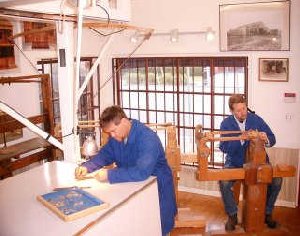

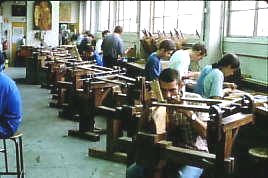

SHADE OR BROWNING

A simple old woman frying pan on any type of stove makes the deal very
well.
The sand known as of Fontainebleau must be very fine.
One
finds it on certain beaches of river or pond, with the career of Fontainebleau?
or in the bird-catchers.
To soak the parts without burning itself, all kinds
of tweezers are appropriate; personally, I use long grips used in surgery
known as haemostatic. Those present a notch of stop not to let escape the
small parts.
The shovels with ombrer presented here are in fact of
the equivocal flattened out of copper, bus storing better the heat, provided
with a long stem and a handle out of wooden. They allow a browning of the
concave round forms.
The use of masks private individuals, or funnels are
also used in quite precise cases.

Tweezers, points fine, sticking papers, plywood support or carpet sécial. Such are the tools that I use for the provisional maintenance of my parts.


Another older but very current method consists in the manufacture and the joining of the parts on a "tended hold": one covers a plywood with tepid water a kraft paper coated beforehand. This makes it possible the kraft to inflate, and the edges of this one are stuck to the back of the panel. While drying, the hold is tightened, and the parts are stuck to a top with the glue which gets busy with the bain-marie, mixture 3/4 sticks bones and 1/4 adhesive of nerve (conditioned in pastilles) seeming most usually employed.

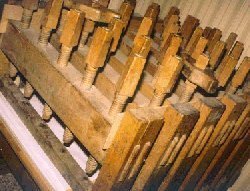
If for small tables some good screw clamps are enough, for larger parts, it is essential that the pressure is strong in any point: The press presented here in alder and ash solid masses, consists of 7 frames of 5 jacks each one, and has a passage of 85 cm.


Other frames largely used are wood manufactured or IPN in shape of H, and the threaded rods of strong diameter.


SANDPAPERING AND COMPLETIONS
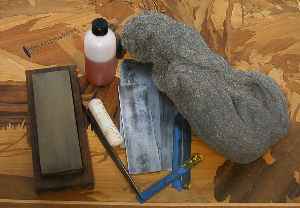

One sees here several types of scrapers, of which artisanal scrapers
manufactured starting from ULTRA webs, of the ends of webs to ribbon.
The
sharpening of these scrapers is not really simple, and a good blow of hand is
necessary; and even with the practice, sometimes one can miss the wire very well
by the scraper.
The tools for sharpening are a stone with oil as well
as an ad hoc lubricant, an oilstone, old third point without tooth, a
piece of tallow of candle for the corrosive one.
The steel 000 wool is also used for the completions.
The electric
grinder most practical is the eccentric grinder, which combines the
rotary movements, and eccentric. Progressive speed by support and the dust
extraction make a perfect tool of it.
The finishing sander can also be
used.
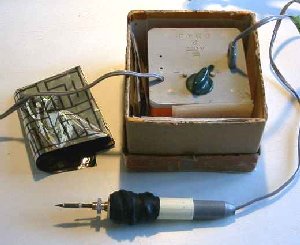
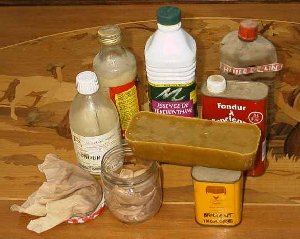
An iron to be pyrographed can be used to carry out the signatures and
other small features.
This one can easily be replaced by kerfs filled
then.
The varnishes and the waxes are a chapter with whole share in the art of
marquetry.
The grains of current papers go from 400 to 4000. Let us quote
simply some completions usually used:
